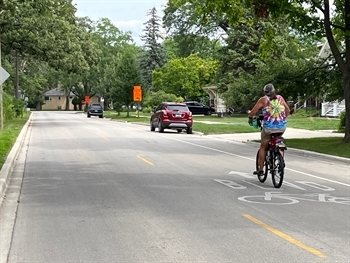Walking the Talk in Brookfield

Pedestrian and cycling infrastructure is for everyone because transportation impacts everyone. Communities that implement plans for active transportation are seeing positive community outcomes from increased sustainable, safe, and healthy options for people to travel, especially for children, youth, the elderly, people with disabilities, and those with lower incomes. Improving conditions for biking and walking is key to creating healthier and vibrant communities and opportunities for mental well-being while connecting people to nature and reducing traffic congestion and emissions.
To directly experience the role of active transportation in reducing carbon emissions in our region, nearly 100 people attended an August 2022 walking tour of Brookfield, as part of the event series Taking Climate Action by Prioritizing Walking, Biking, and Transit, which was held in partnership with the Active Transportation Alliance and Metropolitan Mayors Caucus. The diverse range of participants included staff from local government and regional agencies, planning experts, engineers, and advocacy groups seeking to tackle climate change and improve community quality of life by improving walking and biking.
Suburban municipalities like Brookfield have been historically designed to be automobile-oriented and low-density. Developing alternatives to driving has typically been viewed as challenging to implement given suburban land use patterns. However, Brookfield has shown how a suburb can make meaningful changes supporting sustainable mobility while keeping the characteristics that locals love. The community is challenging suburban stereotypes and adapting sustainability practices to its needs. These changes were only achieved through the convergence of political will, strong advocacy, and residents’ involvement.
Community Engagement
The tour started in the Village Hall with welcoming remarks from city officials. Participants heard from Trustee Katie Kaluzny, who highlighted the strong support from members of the city council for investments in sustainable transportation. During the lunchtime panel discussion, Village Planner Kate Portillo highlighted the role of community involvement in planning to achieve the vision of sustainability that Brookfield seeks. She highlighted the value of residents’ active role in the planning process through regular participation in public hearings and council meetings. To increase community engagement further, the village is expanding initiatives for public involvement by broadcasting public meetings on YouTube.
Bike Boulevard
During the tour as we approached the Bike Boulevard, we passed Kiwanis Park and the new Canoe Launch on Salt Creek. This walkable green area hosts a farmers’ market on Sundays, and the ample low-impact trails in the adjacent Oak Savanna allow locals to connect with nature. In fact, this green area plays a role in consolidating a corridor for pollinators, connecting the zoo with the creek and the Des Plaines River.

The Brookfield bike boulevard was identified in the 2017 Active Transportation Plan and implemented in the fall of that year. What makes the bike boulevard special? Not a trail or a regular bike lane painted on the street, the bike boulevard is a place where bikes and cars share the space as equals. Local planners saw the Arden Avenue resurfacing plan as an opportunity to make long-term changes. They prioritized bikes in the design and reduced the speed limit along this corridor, along with installing bump outs and high visibility crosswalks.
Transit-Oriented Development
As the groups in the walking tour approached the Brookfield Metra station, building density increased — with a five-story building reflecting the result of local zoning initiatives to promote higher density near transit. Brookfield leaders know that transit-oriented development is crucial to creating sustainable, walkable, and active communities by leveraging the foot traffic around transit stations to create vibrant mixed-use areas. These areas attract more residents to gather, shop and dine, activating downtown spaces. To learn more about the role of TODs in addressing climate change, see the recording of the recent webinar: Connected & Climate-Resilient: A virtual panel on community and transit-oriented development.
Brookfield is also boosting active transportation through incentives for less parking in new developments near transit. Multifamily homes and mixed-use developments can benefit from the parking credits and reduction stated in the Village Ordinance that provide incentives for new developments and businesses to meet their parking requirements for vehicles in new buildings by providing bike parking or space for shared vehicles. These incentives, along with business partnerships to install bike racks, are increasing the vibrancy of the downtown commercial corridor and encouraging access by sustainable transportation modes.
The Role of Advocacy
Cycle Brookfield is one of the most active suburban cycling advocacy groups in the region. The group has had a significant role in partnering with the village on developing bike infrastructure as well as building bike culture in the community. For example, Cycle Brookfield holds weekly Slow Roll Social Rides throughout the year for all ages and abilities and cultivates a welcoming tone with new riders. They also offer bike valet parking at the farmers market to encourage people to ride. City staff and Cyle Brookfield co-founder Chris Valdez highlighted the value of advocates working productively with city leadership and raising the concerns of the community on an ongoing basis to generate results.
The Bike Tour: Accomplishments and Challenges
After the walking tour, some participants took off on a group bike ride to experience community highlights and also acknowledge some challenging locations the community is working to address. Tour participants rode in the bike boulevard and continued on to 31st Street as it leads to the famous Brookfield Zoo. The group viewed a challenging spot on busy 31st Street where between a bridge and the Zoo there are no sidewalks. Visitors and residents regularly struggle to access the zoo entrance on foot along the side of the road. The village acknowledged that this is a widely known issue, but engineering solutions will be very difficult. However, it must persist in working with partners like the Illinois Department of Transportation, which owns the roadway, to find solutions and create safe access. Brookfield leaders know that the benefits of walkability are worth the effort.

Key Takeaways
For many suburban municipalities, it is challenging to envision bold new planning strategies that will lead to substantially improved biking a walking infrastructure. Brookfield shows the potential of suburban communities to incorporate progressive policies in their planning to achieve significantly improved sustainable transportation options. Key lessons of this tour highlight opportunities for suburban areas to improve active transportation to reduce carbon emissions.
- Suburban areas can prioritize sustainable practices in their infrastructure planning to make biking, walking, and transit significantly safer and more attractive. Improving mobility for people of all ages and abilities improves community character and economic competitiveness while addressing climate change.
- The Brookfield example shows how improvements can be implemented as part of ongoing maintenance activities so that regular progress is being made. By taking advantage of opportunities like resurfacing streets, communities can more quickly facilitate the integration of pedestrian- and bike-friendly features into transportation investments.
- Proactive advocacy groups, along with political will by community leaders, can result in productive engagement that results in meaningful improvements. Collaboration between the city council, village staff, and residents has resulted in more inclusive and sustainable policy implementation.
These highlights show how we can evolve our communities toward greater sustainability and inclusivity. By incentivizing sustainable transportation modes, we can build resilient communities that work better for residents at all stages of life.
To access resources from the event series, visit this page. To hear about future events, sign up for our newsletter at Newsletter – Metropolitan Planning Council.
